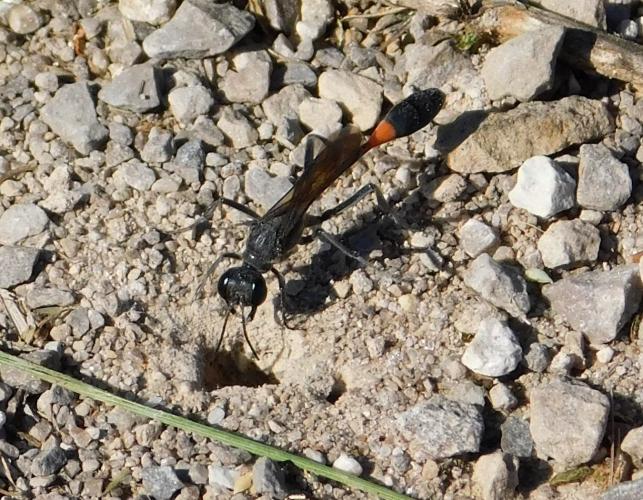
There are more than 60 species of wasps in genus Ammophila in North America, and it can be difficult to identify them to species. They tend to be medium-sized, slender, and generally black, with some amount of orange on the abdomen (the hindmost part of the body). There is a narrow constriction between the thorax and abdomen (thus the name "thread-waisted"). The abdomen is straight or points downward at the tip (it does not point upward). Males are more slender than females and usually have less orange or red color than the females.
Similar species: Ammophila is just one genus in the large and diverse thread-waisted wasp family. Other thread-waisted wasps include the genera Chlorion, Podium, Chalybion and Sceliphron (both called mud daubers), Isodontia (including grass carrier wasps), Palmodes, Prionyx, and Sphex (including the great golden digger wasp and great black wasp).
As they fly rapidly and low to the ground, female ammophila wasps, having rather wispy bodies, may at first seem like damselflies. Their habitual nervous wing flicking may make them seem like ichneumons.
Length: usually ¾ to 1 inch; some species are 1½ inches long.
Statewide.
Habitat and Conservation
Ammophila wasps are solitary; they do not live in colonies, and as a result they are not defensive of territories the way paper wasps and yellow jackets are. Females of Ammophila species dig burrows into the ground in which they deposit their eggs and host caterpillars. Therefore, ammophila wasps are usually found in places with bare soil or leaf litter on the ground suitable for nesting. Ammophila wasps are also frequently found in open, sunny grasslands where they drink nectar from flowers.
Food
The larva, upon hatching, consumes a paralyzed caterpillar that was provided by its mother for its nourishment. As adults, ammophila wasps drink nectar from flowers, including white sweetclover.
Life Cycle
After mating, the adult female hunts for a suitable host, usually a caterpillar or sawfly, stings it, then drags it into a burrow she has dug in the soil. She lays a single egg on the paralyzed host, then repeats the process with more burrows, caterpillars, and eggs. There can be several broods a year.
Human Connections
These are not aggressive wasps. They will sting only when mishandled. The caterpillars these wasps hunt generally feed on the leaves of plants, so anyone who gardens can learn to appreciate wasps that reduce their populations. Also, the digging of these wasps helps aerate and mix the soil and creates places where rainwater can soak into the earth.
Ecosystem Connections
Many flycatchers and other insectivorous birds are undeterred by the stings of wasps and eagerly snatch them if they can. The underground larvae and their caterpillar pantry are no doubt sought out by moles, shrews, and other insect-eating ground dwellers.





































